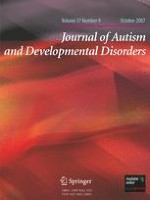01-10-2007 | Original Paper
The Relationship of Asperger’s Characteristics and Schizotypal Personality Traits in a Non-clinical Adult Sample
Gepubliceerd in: Journal of Autism and Developmental Disorders | Uitgave 9/2007
Log in om toegang te krijgenAbstract
The study examines the relationship between Asperger’s Disorder (AD) and Schizotypal Personality Disorder (SPD), mutually exclusive but similar diagnoses [DSM-IV-TR; American Psychiatric Association (2000). Diagnostic and statistical manual of mental disorders. Washington, DC: Author]. The literature and comparison of diagnostic criteria suggest that the two disorders may overlap: AD social impairment with SPD interpersonal problems and AD communication deficits with SPD disorganized features. Questionnaire measures of AD and SPD were administered to a large non-clinical adult sample. Consistent with expectations, the Asperger’s and Schizotypal questionnaires were positively correlated. Further, the social-interpersonal and communication-disorganized areas were positively correlated, though the relationship between social-interpersonal areas is particularly strong. Future research should continue to explore the relationship between AD and schizotypy to confirm current findings and improve understanding of distinctions between the disorders.
